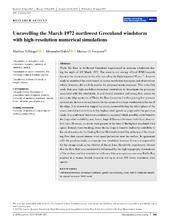| dc.contributor.author | Tollinger, Mathias | |
| dc.contributor.author | Gohm, Alexander | |
| dc.contributor.author | Jonassen, Marius Opsanger | |
| dc.date.accessioned | 2020-04-16T08:33:44Z | |
| dc.date.available | 2020-04-16T08:33:44Z | |
| dc.date.issued | 2019-08-07 | |
| dc.Published | Tollinger M, Gohm A, Jonassen MO. Unravelling the March 1972 northwest Greenland windstorm with high-resolution numerical simulations. Quarterly Journal of the Royal Meteorological Society. 2019;145(725):3409-3431 | eng |
| dc.identifier.issn | 1477-870X | en_US |
| dc.identifier.issn | 0035-9009 | en_US |
| dc.identifier.uri | https://hdl.handle.net/1956/21892 | |
| dc.description.abstract | Thule Air Base in northwest Greenland experienced an extreme windstorm during the night of 8/9 March 1972. The event is not among official WMO records because the anemometer broke after recording the highest gust of 93 m s−1. A recent study re‐examined the event based on coarse‐resolution reanalyses and observations which, however, did not fully resolve the proposed storm processes. This is the first study that uses high‐resolution numerical simulations to investigate the processes associated with this windstorm. A cold‐frontal inversion and strong flow across the mountain ridge upstream of Thule Air Base (associated with a passing low pressure system) are shown to be key factors for the severe downslope windstorm in the lee of the ridge. It is shown that trapped lee waves occurred during the initial phase of the storm, but did not contribute to the highest wind speeds as proposed in the previous study. It is confirmed that rotor circulations occurred which possibly contributed to the large wind variability and, hence, large differences between individual observation sites. However, no rotors were present at the time of the highest simulated wind speed. Instead, wave breaking above the lee slope is found to indirectly contribute to the wind maxima by facilitating Kelvin–Helmholtz instability at the top of the shooting flow that caused intense wind speed pulsations near the surface. In agreement with the previous study, a corner jet was simulated, however it was not responsible for the strong winds in the vicinity of the air base. Sensitivity experiments showed that the flow field was considerably influenced by the high topography downstream of the air base and that simulations with very thin or no sea ice cover over Baffin Bay resulted in a weaker frontal inversion and up to about 30% lower maximum wind speeds. | en_US |
| dc.language.iso | eng | eng |
| dc.publisher | Wiley | en_US |
| dc.rights | Attribution CC BY | eng |
| dc.rights.uri | http://creativecommons.org/licenses/by/4.0/ | eng |
| dc.subject | cold-frontal inversion | eng |
| dc.subject | downslope windstorm | eng |
| dc.subject | gravity-wave breaking | eng |
| dc.subject | rotors | eng |
| dc.subject | Kelvin–Helmholtz instability | eng |
| dc.subject | trapped lee waves | eng |
| dc.subject | WRF model | eng |
| dc.title | Unravelling the March 1972 northwest Greenland windstorm with high-resolution numerical simulations | en_US |
| dc.type | Peer reviewed | |
| dc.type | Journal article | |
| dc.date.updated | 2020-02-12T14:32:05Z | |
| dc.description.version | publishedVersion | en_US |
| dc.rights.holder | Copyright 2019 The Author(s) | en_US |
| dc.identifier.doi | https://doi.org/10.1002/qj.3627 | |
| dc.identifier.cristin | 1738150 | |
| dc.source.journal | Quarterly Journal of the Royal Meteorological Society | |

